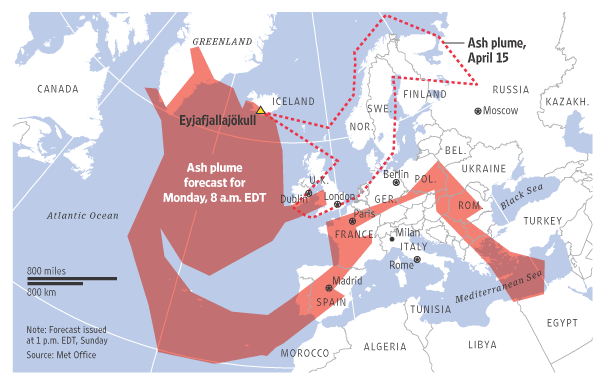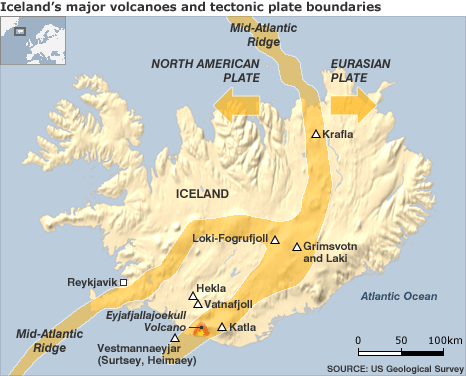Volcano Air Travel Disrupted Over Europe Again
Posted By thestatedtruth.com on May 10, 2010
Satellite photo of Iceland’s Eyjafjallajökull volcano May 7th, 2010 (via NASA Earth Observatory)Â
I know right now everyone is focused on the drama playing out in Europe over Greece et. al., but there is another little sideshow being produced over there by Mother Nature which has the potential to take centerestage and prove to be equally, if not more, devastating.
It is being reported that the Icelandic volcano Eyjafjallajokull is again causing flight disruptions across Europe, although not to the extent of the previous disruption in April, which was one of the largest in Europe post WWII and caused Eurocontrol, the agency in charge of European air traffic, to shutdown airports across Europe for six days. It grounded more than 100,000 flights and cost the airlines approx. $1.7 billion in lost sales.Â
The Current Disruption
The bulk of the cloud measures 2100 miles long and 1400 miles wide. The main ash cloud is spread over the North Atlantic with an offshoot spreading from Portugal through Spain, southern France and northern Italy, then up to Germany, the Czech Republic and Austria. A high pressure system in the mid-Atlantic is expected to continue to drive northerly winds into Europe for the next few days thus increasing the chances of further disruption.Â
Eurocontrol is reporting today that around 1500 flights were cancelled on Sunday. Flights were affected in Italy, France, Spain, Portugal, Germany, Switzerland, Ireland, Austria and Croatia. Regional airports in Spain France and Italy were closed for much of Sunday. Although no airports are closed today, about 500 fewer than normal flights are expected.
Scientists have produced the first internal map of Eyjafjallajokull’s network of magma chambers, which extend 12 miles below the ground.The map shows how the volcano’s tubes plunge deep down through the earth’s crust to the start of the mantle, which is made of semi-molten rock. It reveals the huge scale of the eruption and the potential for a far greater one. This is because the magma chamber of Eyjafjallajokull is dwarfed by the much larger one under Katla, a volcano 15 miles to the east. Two of Katla’s eruptions, in 1612 and 1821, are thought to have been triggered by those of its neighbour.The workings of the volcanoes have been provisionally drawn up by Professor Erik Sturkell, a geologist at the Nordic Volcanological Centre, University of Iceland. Sturkell suggests the Eyjafjallajokull eruption has been building since 1994, when new lava began rising, forming two reservoirs three miles beneath the volcano. They now feed into a much larger magma chamber a mile under the crater.A surge of earthquakes under Katla mean it has experienced a similar influx of lava, Sturkell said. “This suggests the volcano is close to failure [eruption].”
Â
Â



Comments